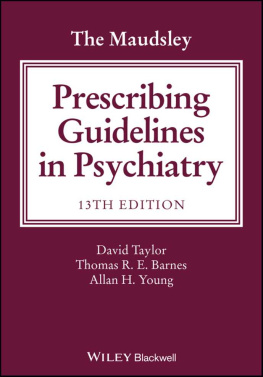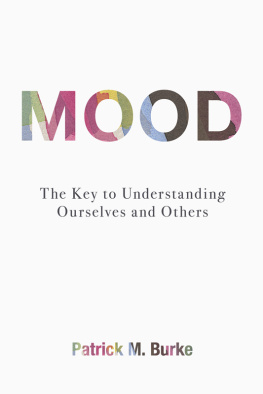THE PSYCHOTHERAPISTS GUIDE TO PSYCHOPHARMACOLOGY

Copyright 1990 by The Free Press
A Division of Macmillan, Inc.
All rights reserved. No part of this book may be reproduced or transmitted in any form or by any means, electronic or mechanical, including photocopying, recording, or by any information storage and retrieval system, without permission in writing from the Publisher.
The Free Press
A Division of Macmillan, Inc.
866 Third Avenue, New York, N.Y. 10022
www.SimonandSchuster.com
Maxwell Macmillan Canada, Inc.
1200 Eglinton Avenue East
Suite 200
Don Mills, Ontario M3C 3N1
Macmillan, Inc. is part of the Maxwell Communication Group of Companies.
Printed in the United States of America
printing number
4 5 6 7 8 9 10
Library of Congress Cataloging-in-Publication Data
Gitlin, Michael J.
The psychotherapists guide to psychopharmacology / Michael J. Gitlin.
p. cm.
Includes bibliographical references.
ISBN 0-02-911781-X
ISBN-13: 978-0-029-11781-1
eISBN-13: 978-1-439-13668-3
1. Psychopharmacology. 2. Psychotherapists. I. Title.
[DNLM: 1. Mental Disordersdrug therapy. 2. Psychotropic Drugspharmacology. 3. Psychotropic Drugstherapeutic use.]
RM315.G57 1990
616.8918dc20
DNLM/DLC
for Library of Congress 90-1734
CIP
To my mother, Beatrice Gitlin, who showed me the value of sensitivity and to the memory of my father, Hyman Gitlin, M.D., who demonstrated the art of being a physician
Contents
SECTION ONE

SECTION TWO

SECTION THREE

Mourning
Demoralization
Personality Disorders
Adjustment Disorder with Depressed Mood
Premenstrual Syndrome
Dementia Syndromes
Cyclic Antidepressants
Monoamine Oxidase (MAO) Inhibitors
Lithium
Alprazolam
Electroconvulsive Treatment (ECT)
Light Therapy
Strategies Used in Treatment-Resistant Depressions
Alternative Treatments of Acute Schizophrenia
Diagnosis
Pharmacotherapy
Diagnosis
Pharmacotherapy
Diagnosis
Pharmacotherapy
Diagnosis
Pharmacotherapy
Diagnosis
Pharmacotherapy
Ennresis
Conduct Disorder
Aggressive, Destructive Behavior in Mentally Retarded Children
Diagnosis
Pharmacotherapy
Mood Disorders
Psychotic Disorders
Anxiety Disorders and Insomnia
SECTION FOUR

Panic Disorder
Clinical Uses
Biologic Effects
Techniques for Prescribing
Side Effects
Clinical Uses
Biologic Effects
Techniques for Prescribing
Side Effects
Acute Dystonia
Extrapyramidal Symptoms
Neuroleptic Malignant Syndrome
SECTION FIVE

The Initial Consultation
Working in an Ongoing Split Treatment
List of Illustrations and Tables
ILLUSTRATIONS

TABLES

1-1 Clinical Characteristics That Should Suggest a Psychopharmacological Consultation 12
3-1 Diagnostic Criteria for Major Depressive Episode 37
3-2 Diagnostic Criteria for Major Depressive Episode, Melancholic Type 38
3-3 Diagnostic Criteria for Manic Episode 41
3-4 Medical Disorders That May Cause Depressive Syndromes 51
3-5 Antihypertensives Associated with Depression 54
3-6 Differentiating Pseudodementia (of Depression) from Dementia 58
3-7 Distinguishing Hypomania from Happiness 59
3-8 Psychopharmacological Treatment Options for Depression 61
3-9 Factors Used in Choosing a Specific Cyclic Antidepressant 62
3-10 Factors Used in Deciding to Prescribe a Monoamine Oxidase Inhibitor 65
3-11 Factors Used in Considering a Maintenance Treatment in Unipolar and Bipolar Mood Disorders 72
3-12 Treatments for Mania and Bipolar Disorder 75
4-1 Diagnostic Criteria for Panic Disorder 81
4-2 Medical Disorders and Drugs That May Cause Anxiety Disorders 87
4-3 Advantages and Disadvantages of Antipanic Medications 93
4-4 Medications for Generalized Anxiety 98
4-5 Common Causes of Insomnia 107
5-1 Diagnostic Criteria for Schizophrenia 115
5-2 Diagnostic Distinctions Among Disorders with Both Mood and Psychotic Symptoms 127
5-3 Alternative Treatments of Acute Schizophrenia 133
6-1 Guidelines for Considering Medications in Treating Bulimia 145
6-2 Medications for Attention Deficit Disorder in Adults 148
7-1 Diagnostic Criteria for Borderline Personality Disorder 167
7-2 Medication Strategies for Personality Disorders 172
8-1 Commonly Used Medications in Child and Adolescent Psychiatry 180
8-2 Diagnostic Criteria for Attention-deficit Hyperactivity Disorder 188
8-3 Special Considerations in the Diagnosis and Psychopharmacological Treatment of the Elderly 195
9-1 Disorders for Which Cyclic Antidepressants Are Useful 205
9-2 Effects of Cyclic Antidepressants on Neurotransmitter Systems 209
9-3 Cyclic Antidepressants 212
9-4 Antidepressants for Which Therapeutic Blood Levels Are Established 215
9-5 Common Side Effects of Cyclic Antidepressants 220
9-6 Other Side Effects of Cyclic Antidepressants 221
9-7 Disorders for Which MAO Inhibitors Are Useful 226
9-8 Monoamine Oxidase Inhibitors 227
9-9 Food Restrictions for Patients on MAO Inhibitors 234
9-10 MAO InhibitorsMedications to Avoid 236
9-11 Common Side Effects of MAO Inhibitors 237
10-1 Disorders for Which Lithium Is Useful 242
10-2 Lithium Preparations 246
10-3 Situations in Which Lithium Levels Should Generally Be Checked 248
10-4 Lithium Side Effects 249
10-5 Signs of Lithium Toxicity 253
11-1 Disorders for Which Benzodiazepines Are Useful 263
11-2 Benzodiazepines 269
11-3 Characteristics of Benzodiazepines 270
11-4 Possible Symptoms of Benzodiazepine Withdrawal 275
11-5 Factors Predicting Benzodiazepine Withdrawal Symptoms 276














